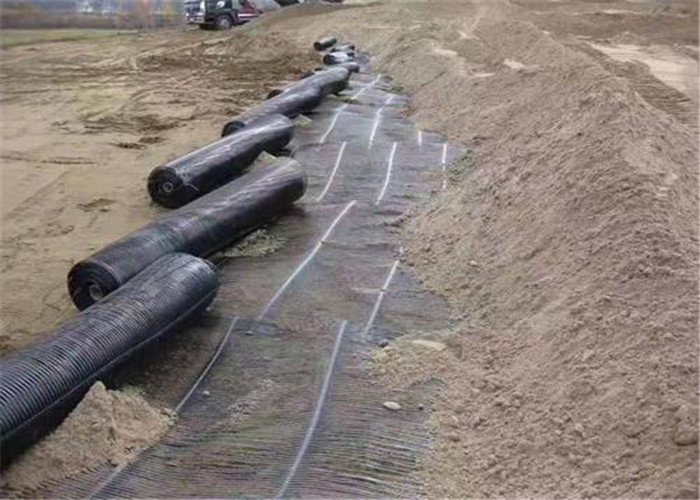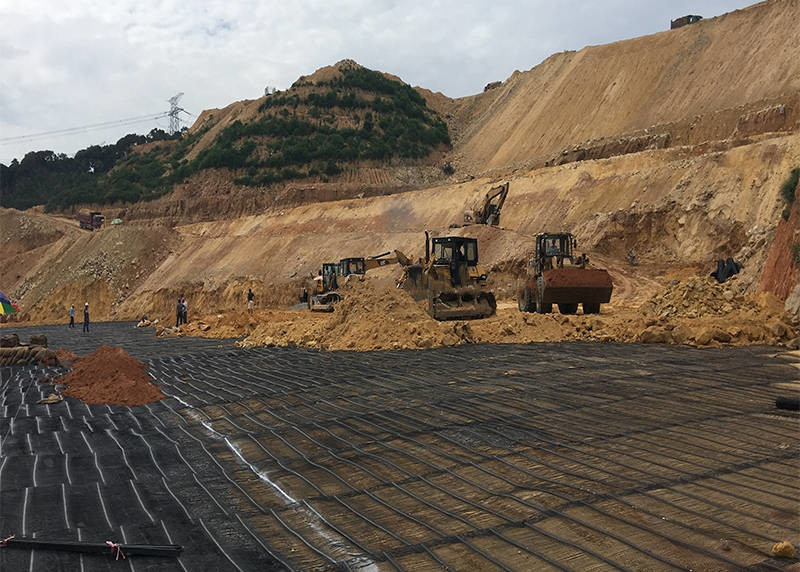High Strength Road Construction Pp Uniaxial Plastic Geogrid For
Retaining Wall
Uniaxial Plastic Geogrid Introduction
Polyethylene uniaxially stretched geogrid is made of high-density
polyethylene (HDPE) as raw material, plasticized, extruded,
punched, heated, and stretched. Through stretching, the originally
scattered chain-shaped molecules are reoriented to a linear state,
which fully improves the tensile strength and rigidity of the grid.
Laying it in the soil, through the occlusion and interlocking
between the grid mesh and the soil, a stress transmission mechanism
is formed, so that the local load can quickly and effectively
spread to a large area of soil, thereby achieving The purpose of
reducing local damage stress and increasing the service life of the
project.
The outstanding advantage of polyethylene uniaxially stretched
geogrid is that it has little tendency to deform (creep) under
long-term continuous load, and its creep resistance is much better
than other geogrids, which is important for improving the service
life of the project. effect.
This product is suitable for the construction of roads, railways
and reinforced retaining walls, dams, bridge decks, steep slopes
and geocells on the coast of rivers and lakes. Its function is to
increase the bearing capacity of the retaining wall or dam, extend
the service life, reduce the floor space, shorten the construction
period, reduce the construction cost, and reduce the maintenance
cost.
The unidirectionally stretched geogrid is formed by extruding a
high molecular polymer into a thin plate, punching a regular mesh,
and then stretching it longitudinally. In this process, the polymer
becomes a oriented linear state and forms an oblong network
integral structure with uniform distribution and high node
strength. This kind of structure has quite high tensile strength
and tensile modulus, especially our company's products of this kind
have a high early stage (elongation rate of 2%-5%) tensile strength
and tensile modulus that exceed the international level. . It
provides the soil with an ideal interlocking system for bearing and
spreading forces. The product has high tensile strength
(>150Mpa), adapts to various soils, and is currently a widely
used reinforcement material.
Uniaxial Plastic Geogrid Specification
| Properties | GG60PP | GG80PP | GG110PP | GG150PP | GG260PP | GG300PP |
| Tensile Strength (kN/m) | 60 | 80 | 110 | 150 | 260 | 300 |
| Elongation Ratio | ≤10% | ≤10% | ≤10% | ≤10% | ≤10% | ≤10% |
| Strength at 2% Elongation (≥kN/m) | 17 | 26 | 32 | 45 | 94 | 105 |
| Strength at 5% Elongation (≥kN/m) | 35 | 48 | 64 | 90 | 185 | 195 |
| Roll Length (m) | 100 | 100 | 50 | 50 | 50 | 50 |
| Roll Width (m) | 1-3 | 1-3 | 1-3 | 1-3 | 1-3 | 1-3 |
Uniaxial Plastic Geogrid Feature
1. The polymer is in the shape of a directional line, forming a
long oval network structure with uniform distribution and high node
strength. This structure has quite high tensile strength and
rigidity, and provides ideal bearing capacity and diffusion
interlocking system for the soil.
2. The outstanding advantage of unidirectional plastic geogrid is
that it has a small tendency to deform (creep) under long-term
continuous load, and its creep resistance is much better than other
materials, which plays an important role in improving the service
life of the project.
3. The occlusion and interlocking of the grid and the soil
constitutes an efficient stress transmission mechanism, which
enables the local load to be quickly and effectively spread to a
large area of soil, thereby reducing local damage stress and
increasing the service life of the project.
Plastic Uniaxial Geogrid Fuction
What is the function of the one-way geogrid? The one-way grille is
commonly used in northern areas. The two-way geogrid is mainly used
in areas that have different requirements for the positive and
negative increase limits of the geogrid in different regions and in
different seasons, climate, orientation, natural disasters, and
production environment. Especially when the two-way direction is
negative increase limit, the two-way grid should be used to fill
these amounts to play a filling role. Definition and principle of
one-way geogrid A one-way geogrid is a three-dimensional geogrid
used in the contaminated area of stone and gravel waters. The
one-way grille is mainly aimed at the water environment of stone
and crushed stone. The product quality is advanced, the structure
is simple, and the construction is convenient. The one-way grid can
appear as a green product in some cases, and is often used in urban
environmental landscapes where the green area is large and the
negative increase limit is relatively large. At the same time, the
garden three-dimensional vehicle with one-way grille can also be
used in special orientation (head or tail). Definition and
principle of two-way geogrid Two-way geogrid is aimed at water
pollution and overall pollution inside the stratum. The application
of two-way grille is wider than one-way, and it must be adjusted
according to the conditions after construction. The construction of
two-way grids causes great natural and artificial pollution to the
building and the surrounding water body, and the construction is
cumbersome, and the flexibility of combination and design is not
strong.
Uniaxial Plastic Geogrid Usage
It is suitable for all kinds of roads, railway lines, and airport
subgrade projects to improve ground improvement.
It is suitable for permanent installation of subgrade improvement
such as large and medium-sized underground parking lots and port
freight stations.
The slopes of railway lines and roads can be used for greening.
The available tunnels are improved.
It is suitable for the secondary increase of the steep slope after
the one-way extension of the geogrid is raised to further increase
the steep slope and avoid soil erosion.
Mine mining, pit structure reinforcement
Construction method of one-way geogrid:
Construction method of one-way geogrid:
When used on roadbeds and pavements, the construction method is the
same as the two-way geogrid. When used for reinforced soil
retaining walls, the construction methods are as follows: 1. Set up
the foundation and carry out construction according to the designed
wall system. When precast reinforced concrete panels are selected,
they are generally supported on a precast concrete foundation with
a thickness of 12-15 cm. The width is not more than 30cm, the
thickness is not less than 20cm, and the buried depth is not less
than 60cm to prevent the influence of frost heave of the
foundation.
3. For laying of reinforcements, the main strength direction of the
reinforcements should be perpendicular to the wall and fixed with
pins. isD Feicheng Lianyi Engineering Plastics Co., Ltd.
4. The wall shall be filled with soil by mechanical filling, and
the distance between the wheel and the reinforcement shall be kept
at least 15 cm. After compaction, a layer of soil is about 20-15 cm
thick. isD Feicheng Lianyi Engineering Plastics Co., Ltd.
5. During wall construction, geotextiles should be covered on the
wall to prevent leakage of the fill.
Company introduction:
Hengquan company was established in 2013, has become one of the
leading and professional manufacture of many kinds of Geosynthetics
and wire mesh.
(such as:Geocell,Geotextile,Geomembrane, Geogrid,, ,Gabion
box,Welded wire mesh panel) in the world market. We got quality
control to make sure every product be in good quality, which can
make sure that any bad products will not sent to clients.
We got customers from American, Canada, Russia,Gemany and over 20
countries and enjoy good reputation.


Welcome to contact.
Leo
Manager of Hengquan company
Phone/Whatsapp/Wechat: +8615030705799


